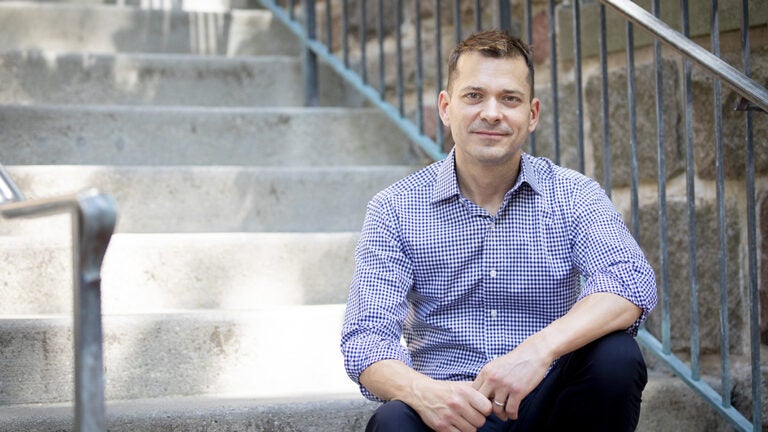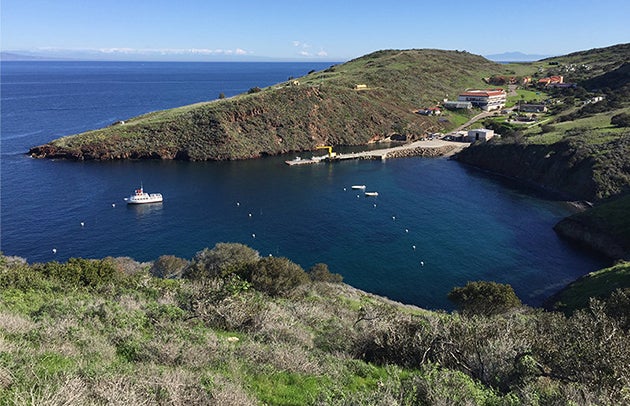
Risk and decision sciences expert Joe Árvai takes the lead on sustainability efforts
Joe Árvai was a newly minted marine scientist in the late ’90s when he stood before a small crowd to tell them about the danger of excessive underwater nutrients. The phenomenon, known as eutrophication, breeds bacteria that monopolize oxygen, suffocating aquatic animals.
Gathered as they were near an estuary on the Frasier River in British Columbia, Árvai assumed the people who had come to hear his presentation would be interested in what he had to say.
They weren’t.
“It struck me that peoples’ minds were already made up whether the problem was serious or even existed,” Árvai said. “People knew where they stood on the issue regardless of what I said.”
It was at that moment that Árvai realized that facts weren’t enough to advance good science or effective policy.
He had to find a way to break through people’s preconceived notions, prejudices, political biases and other cognitive barriers to help them understand environmental science, which was already flashing a bright red warning light.
So he enrolled in the University of British Columbia, not to study more marine science, but to earn his Ph.D. in a branch of psychology that looks at how people assess risk and make decisions.
Move quickly to ensure a livable future
Amber Miller, dean of the USC Dornsife College of Letters, Arts and Sciences, saw incredible potential for the College to carve out a new space in environmental research.
Other research universities were building initiatives focused on science and engineering to improve things like solar and battery technologies. Indeed, USC Dornsife was conducting its own promising research in these areas. And its social sciences researchers were advancing economic theories to create a more sustainable environment and exploring issues of politics, policy, and environmental justice. Its humanists were putting environmentalism into context.
Miller’s vision was to leverage all of the College’s unique strengths to create something entirely new.
Over the past four years, she and her team have been erecting the building blocks for her vision: hiring and retaining the best faculty; building the Academy in the Public Square initiative that encourages faculty to share their expertise with the public; launching Public Exchange, which matches scholars with the private and public sectors to solve societal challenges; initiating the USC Dornsife Center for the Political Future; and forming collaborations with USC’s professional schools.
Properly combined, these assets will enable the college to tackle one of the great unanswered questions of our time: How can we move faster, on an individual and societal level, to avoid global environmental catastrophe?
“Preserving our natural environment is not just a question of science. It is a question of politics, of policy, and of our societal capacity to respond before it is too late,” said Miller. “We need to find ways to break through the roadblocks that prevent more meaningful action.”
Miller realized that USC Dornsife’s Wrigley Institute for Environmental Studies could lead this multidisciplinary initiative to look at the entire spectrum of environmental research with a special emphasis on understanding how to more quickly establish policies and practices aimed at ensuring a livable future. The institute was already conducting environmental research, and its mission included connecting science with environmental policy.
But it needed a leader who was versed in both environmental science and human behavior.
West to greener pastures

It’s Oct. 27, 2020 and Árvai has been driving alone for several days. He started out in Detroit, and he’s not far from Laramie, Wyoming. It’s Big Sky Country, but today’s sky is obscured by light snow and some hail. He’d prefer to be riding his BMW R1200 if it weren’t so cold, and if it could carry all the belongs that are piled into his car.
He’s heading west and expects to arrive in Los Angeles in a few days to take up the position as Dana and David Dornsife Chair and professor of psychology, and director of the Wrigley Institute.
“I was drawn to the Wrigley Institute for Environmental Studies, not only because of the work it had done in the past around marine and environmental science, but because of the potential there to be so much more when it comes to lighting the way on broad sustainability,” he said during a break from driving.
Árvai said the Wrigley Institute has an exciting opportunity to “fill a gap between really interesting high-quality work on the natural science side … [and] a real opportunity to inject a needed, heavy dose of social and behavioral science as well, to really truly do interdisciplinary work at the interface of environment and people.”
Árvai, who left his position as director of the Erb Institute for Global Sustainable Enterprise at the University of Michigan, is also excited by the willingness of California, especially L.A., to invent a more sustainable way of living. He can try things, and get things done, here that he can’t elsewhere.
But more than anything, it was USC’s growing ambition to become a powerhouse for innovative environmental research that caused him to pack his bags.
“Amber [Miller’s] vision and leadership really sold it for me,” he said. “Couple that with President [Carol L.] Folt’s commitment to sustainability, and it seemed like kind of the perfect storm of opportunity that a scientist like me dreams of.”
“The planet is talking to us”
Árvai divides sciences into two broad categories. The first encompasses the fundamental research to understand a given phenomenon. The second is use-inspired science, whereby researchers test solutions to a particular challenge. He wants the Wrigley Institute to combine the two.
That will take some doing. The Wrigley Institute and its antecedents have been home to marine scientists since the turn of the 20th century. And while it has undertaken a growing amount of terrestrial research, it has engaged less with the social sciences and humanities.
“We need to turn the Wrigley Institute into a hub that attracts researchers from across the natural, social, and behavioral sciences,” Árvai said. “But we can’t stop there; we need to give them a platform whereby their work can inspire and accelerate social and environmental change.”
Stemming from his own research, Árvai says there is an urgent need for scientists to bridge the gap between identifying problems and offering solutions. “To get from the diagnosis of a problem to the implementation of any potential solution, people inevitably need to make some tough decisions,” Árvai said. “Figuring out how to best support those decisions, and the tradeoffs that are central to them, is what we’re setting the Wrigley Institute up to do.”
Considering the severity of the sustainability challenges facing California, the United States, and rest of the world, Árvai and his team at the Wrigley Institute have their work cut out for them. Not only is the work vital, many see it as long overdue.
“The planet is talking to us, and more and more scientists, policy-makers and people are listening,” he said.
But, before hanging up the phone and continuing his drive to L.A., he added: “The problem is, listening isn’t enough anymore. We need to get to work.”